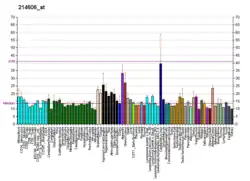TSPAN2
Tetraspanin-2 is a protein that in humans is encoded by the TSPAN2 gene.[5][6][7]
| TSPAN2 | |||||||||||||||||||||||||||||||||||||||||||||||||||
|---|---|---|---|---|---|---|---|---|---|---|---|---|---|---|---|---|---|---|---|---|---|---|---|---|---|---|---|---|---|---|---|---|---|---|---|---|---|---|---|---|---|---|---|---|---|---|---|---|---|---|---|
| Identifiers | |||||||||||||||||||||||||||||||||||||||||||||||||||
| Aliases | TSPAN2, NET3, TSN2, TSPAN-2, tetraspanin 2 | ||||||||||||||||||||||||||||||||||||||||||||||||||
| External IDs | OMIM: 613133 MGI: 1917997 HomoloGene: 21169 GeneCards: TSPAN2 | ||||||||||||||||||||||||||||||||||||||||||||||||||
| |||||||||||||||||||||||||||||||||||||||||||||||||||
| |||||||||||||||||||||||||||||||||||||||||||||||||||
| |||||||||||||||||||||||||||||||||||||||||||||||||||
| |||||||||||||||||||||||||||||||||||||||||||||||||||
| |||||||||||||||||||||||||||||||||||||||||||||||||||
| Wikidata | |||||||||||||||||||||||||||||||||||||||||||||||||||
| |||||||||||||||||||||||||||||||||||||||||||||||||||
The protein encoded by this gene is a member of the transmembrane 4 superfamily, also known as the tetraspanin family. Most of these members are cell-surface proteins that are characterized by the presence of four hydrophobic domains. The proteins mediate signal transduction events that play a role in the regulation of cell development, activation, growth and motility.[7]
References
- GRCh38: Ensembl release 89: ENSG00000134198 - Ensembl, May 2017
- GRCm38: Ensembl release 89: ENSMUSG00000027858 - Ensembl, May 2017
- "Human PubMed Reference:". National Center for Biotechnology Information, U.S. National Library of Medicine.
- "Mouse PubMed Reference:". National Center for Biotechnology Information, U.S. National Library of Medicine.
- Todd SC, Doctor VS, Levy S (Sep 1998). "Sequences and expression of six new members of the tetraspanin/TM4SF family". Biochim Biophys Acta. 1399 (1): 101–4. doi:10.1016/s0167-4781(98)00087-6. PMID 9714763.
- Berditchevski F (Dec 2001). "Complexes of tetraspanins with integrins: more than meets the eye". J Cell Sci. 114 (Pt 23): 4143–51. doi:10.1242/jcs.114.23.4143. PMID 11739647.
- "Entrez Gene: TSPAN2 tetraspanin 2".
Further reading
- Hemler ME (2002). "Specific tetraspanin functions". J. Cell Biol. 155 (7): 1103–7. doi:10.1083/jcb.200108061. PMC 2199333. PMID 11756464.
- Gregory SG; Barlow KF; McLay KE; et al. (2006). "The DNA sequence and biological annotation of human chromosome 1". Nature. 441 (7091): 315–21. Bibcode:2006Natur.441..315G. doi:10.1038/nature04727. PMID 16710414.
- Gerhard DS; Wagner L; Feingold EA; et al. (2004). "The status, quality, and expansion of the NIH full-length cDNA project: the Mammalian Gene Collection (MGC)". Genome Res. 14 (10B): 2121–7. doi:10.1101/gr.2596504. PMC 528928. PMID 15489334.
- Ota T; Suzuki Y; Nishikawa T; et al. (2004). "Complete sequencing and characterization of 21,243 full-length human cDNAs". Nat. Genet. 36 (1): 40–5. doi:10.1038/ng1285. PMID 14702039.
- Strausberg RL; Feingold EA; Grouse LH; et al. (2003). "Generation and initial analysis of more than 15,000 full-length human and mouse cDNA sequences". Proc. Natl. Acad. Sci. U.S.A. 99 (26): 16899–903. Bibcode:2002PNAS...9916899M. doi:10.1073/pnas.242603899. PMC 139241. PMID 12477932.
External links
- TSPAN2 human gene location in the UCSC Genome Browser.
- TSPAN2 human gene details in the UCSC Genome Browser.
This article is issued from Wikipedia. The text is licensed under Creative Commons - Attribution - Sharealike. Additional terms may apply for the media files.




